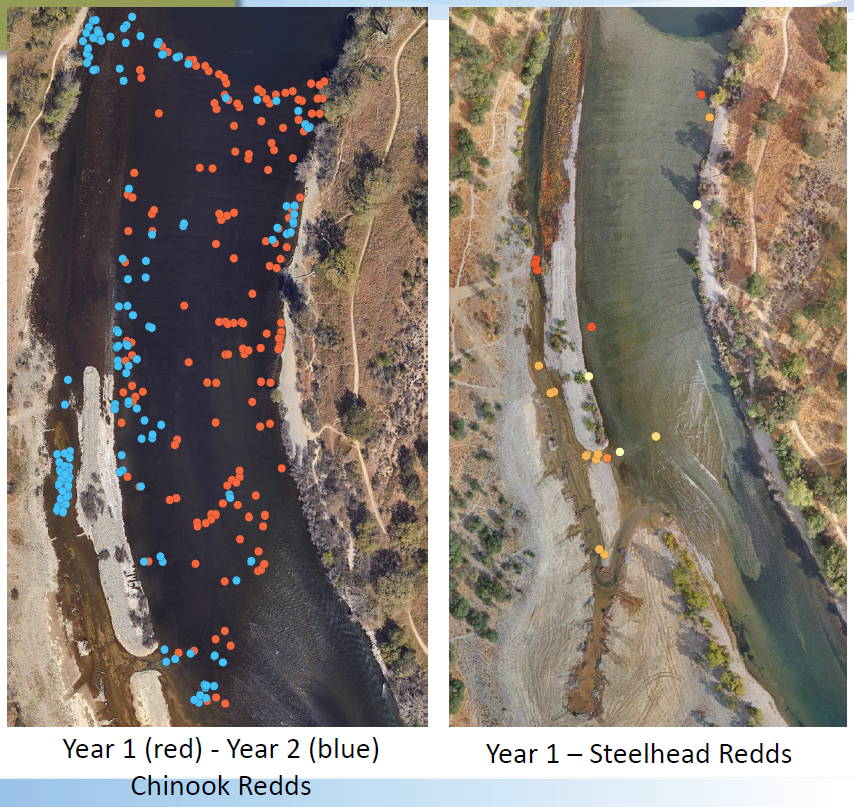Prior to the habitat project, just 64 Chinook redds were counted at this site in fall 2020. A few months after the project, the number of redds had more than doubled to 170.
“This increase is considered even more remarkable given recent drought conditions and warmer river temperatures in 2021,” said Erica Bishop, Water Forum’s Program Manager, adding that the Ancil Hoffman site also attracted 30 percent of the steelhead trout spawning in the entire Lower American River and supported many Pacific lamprey redds in the season after project construction.
“Multiple drought years in a row are challenging for our native fish because they start and end their life cycle along a short stretch of the Lower American and could be subject to harsh local conditions, such as high temperatures, during more than one crucial life stage,” Bishop noted. “Providing more places for our native fish to spawn helps to improve their chances.”
The Ancil Hoffman area is farther down river from where the Water Forum typically finds the heaviest concentration of spawning; however, after the habitat project, about 14 percent of Chinook redds and almost 30 percent of steelhead redds recorded on the Lower American River occurred in this area.
To nurture salmonids, the Water Forum habitat team laid 15,800 cubic yards of clean gravel into the middle of the flowing river that was the right size for building nests. Salmonids need a specific size of gravel, no larger than the size of a fist, to create the redds. Teams also carved a new alcove next to the river to provide protected places for young salmon and steelhead to find protection from predators, forage for food and grow larger before swimming out to the Pacific Ocean.
In a dynamic river like the Lower American, spawning beds degrade through natural processes with time and high flows. Because of Nimbus and Folsom dams, sediment sources that would otherwise replace old gravel washed downstream are blocked. The habitat projects target areas like Ancil Hoffman to replenish gravel up and down the river to help stay ahead of these processes and support the fishery.
Water Forum, with the help of consulting scientists, continues to monitor the area, collect data and evaluate results. This includes monitoring vegetation in and around the rearing alcove. Shortly after the project’s construction, Nature Center volunteers and the Water Forum team planted willows and seeded native grasses and wildflowers in the alcove area. Although some vandalism of the plantings occurred and they’ve been subject to high flows, these species are resilient and are expected to take several years to cover the area as natural processes take hold.
The 2021 project also brought new educational opportunities to the Effie Yeaw Nature Center, including new interpretive signage posted along the Nature Center trails that was funded by the Water Forum and ongoing support for a new exhibit on salmon and steelhead within the museum.
“We appreciate the Water Forum’s focus not only on improving conditions for fish in the river but also for sharing their expertise with the public through a partnership with the Nature Center,” said Kent Anderson, Executive Director of the American River Natural History Association and Effie Yeaw Nature Center.
Because of the area’s importance to fish survival, the Water Forum is planning to return to Ancil Hoffman Park in fall 2023 for another habitat enhancement project in the river across from the Ancil Hoffman Golf Course Driving Range. Information about the 2023 project is posted to the Water Forum’s website at waterforum.org/habitat2023.
Thank You Partners!
The 2021 Habitat Project at Ancil Hoffman Park was made possible through a partnership with the U.S. Bureau of Reclamation, U.S. Fish and Wildlife Service, California Department of Fish and Wildlife, Sacramento Area Flood Control Agency, Sacramento County Regional Parks, Effie Yeaw Nature Center and members of the Sacramento Water Forum.

